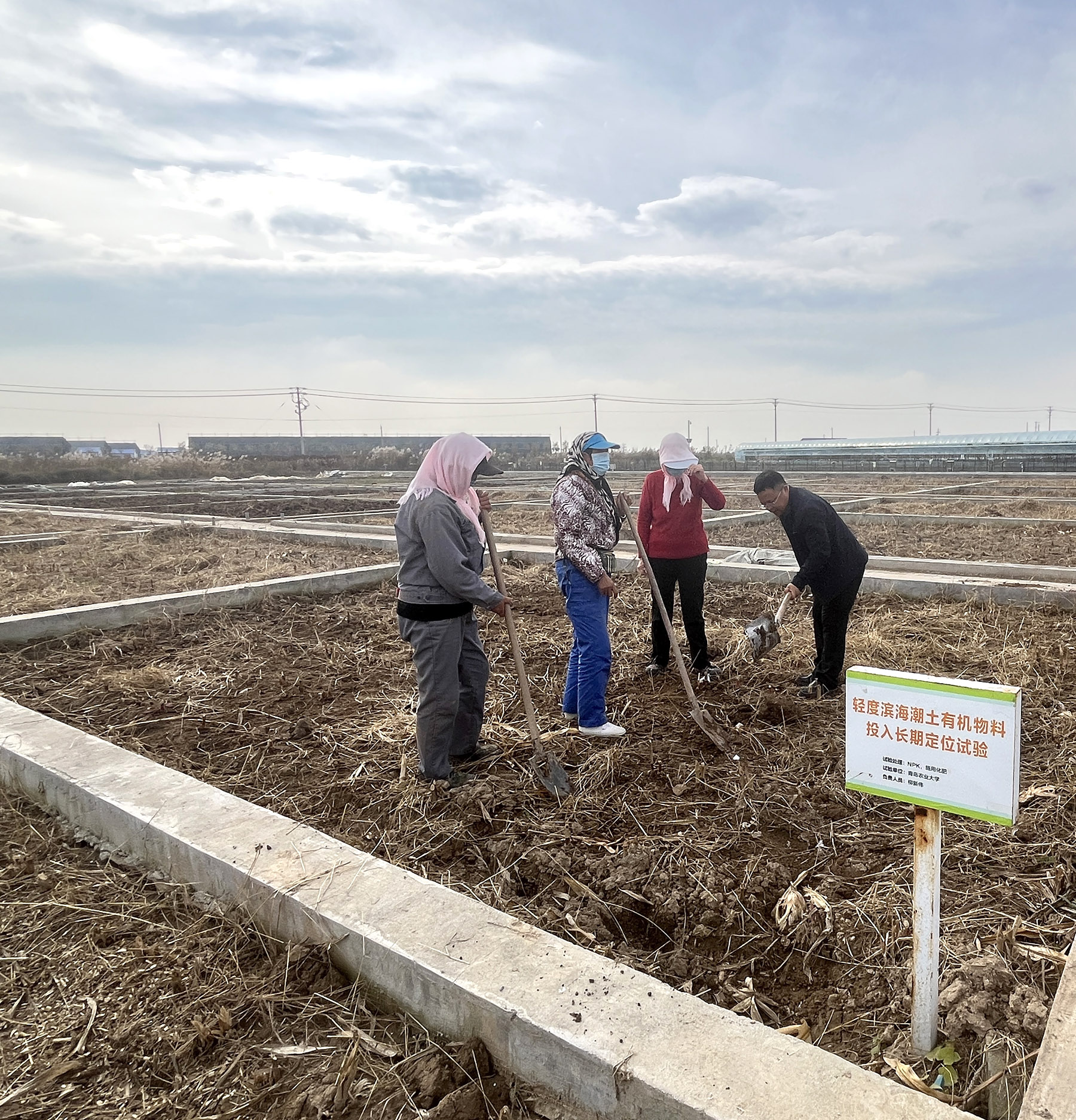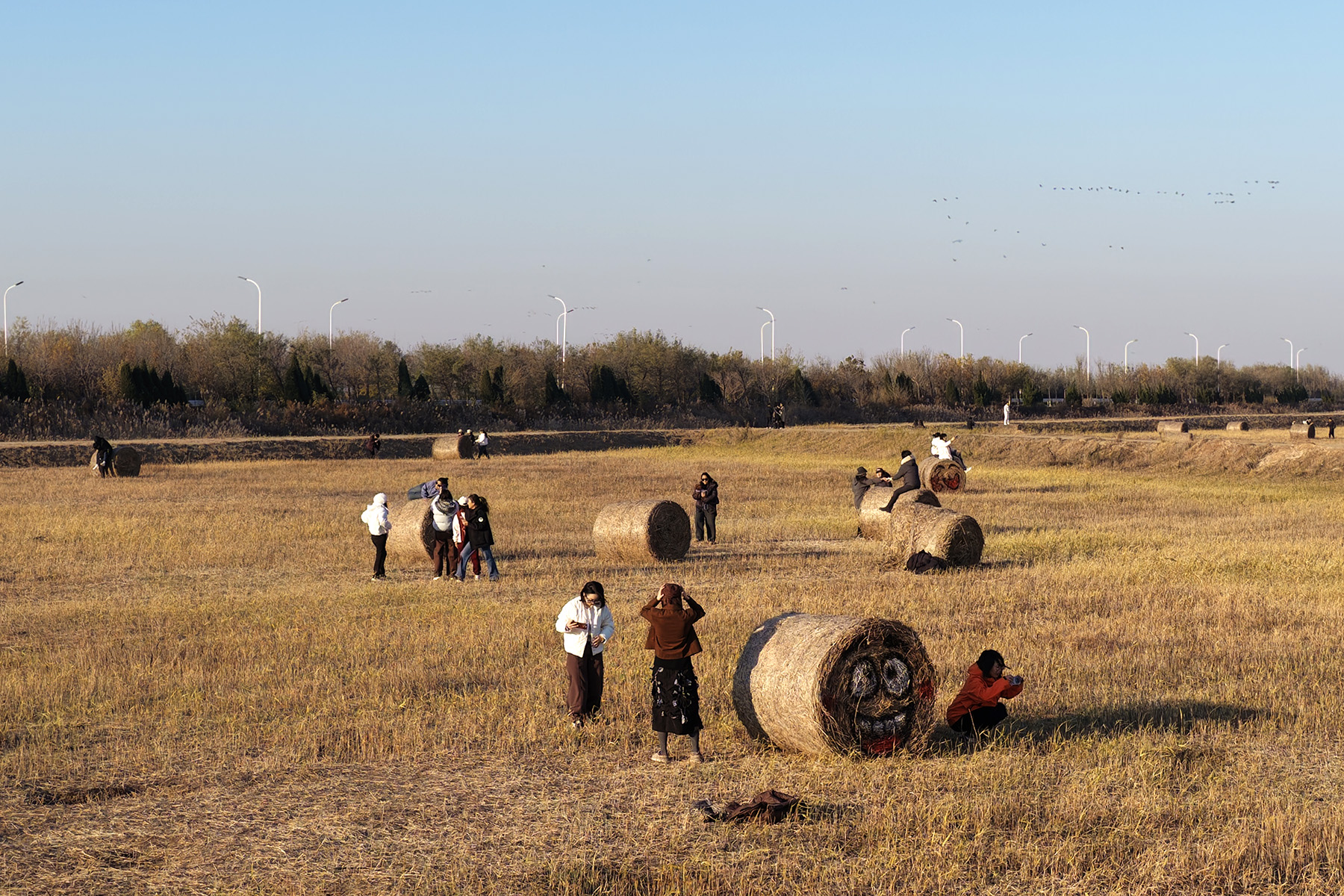District in Shandong transformed by agricultural advances, new seed varieties

Seeders moved up and down the fields placing wheat seeds in the soil in an agricultural district of Dongying, Shandong province, in early November. It's hard to imagine that just over a decade ago this vast expanse in Huanghekou town of Kenli district, was a stark, white expanse of saline-alkaline land.
"Back in 2010, nothing would grow, just sparse cotton with pitifully low yields. The land was considered worthless. Fellow farmers leased it to me for 50 yuan ($7) per mu (0.067 hectare)," said Li Dianquan, a local farmer, as he busily refilled the seeder.
Nestled on the shores of the Bohai Sea where the meandering Yellow River empties into the ocean, Dongying's landscape has been shaped by an unusual geographical legacy.
READ MORE: Moonfaring grass seeds to sprout on Earth
The gradual retreat of seawater over time left behind salt deposits that have so far created 227,330 hectares of saline-alkaline land. This area accounts for 38 percent of the total saline-alkaline land in the province.
"In the autumn harvest season, Shandong's landscape resembles a colorful palette, but the last color we want to see is the white of saline-alkaline land," said Wang Jingdong, deputy director of the Shandong Provincial Department of Agriculture and Rural Affairs.
The fourth plenary session of the 20th Central Committee of the Communist Party of China in October called for enhancing overall agricultural production performance, quality and efficiency. Saline-alkaline land utilization is a crucial part of this effort, holding significant strategic importance for safeguarding national food security and ensuring China's food supply remains firmly in its own hands.
Shandong has integrated the comprehensive utilization of saline-alkaline land into the national strategy for developing the Yellow River Basin. The province is exploring a path characterized by ecological prioritization, adaptation to local conditions, compatibility between seeds and land, and technological support.
"The once white, barren land is now transforming into golden, high-yield fields," said Wang.

Harvesting hope
Li's farmland lies directly across the road from Huanghekou, or the Yellow River Estuary.
He started acquiring land from his fellow villagers in 2010 to carry out large-scale land management.
"At the beginning, I secured around 10 hectares of land. They leased the land to me at very low prices because the land had very low yields," he said.
He rehabilitated the land using methods such as irrigation and deep plowing. "It's very difficult to increase grain yield during the first three to five years, but later with the local government's support and also after accumulating some experience, the grain yield increased," he said.
Today, Li manages 66 hectares of saline-alkaline land, practicing the compound cultivation of wheat, corn and soybeans in the same fields.
"Now the government provides subsidies. In a normal year, 1 mu of land can create a gross revenue of over 2,000 yuan after two seasons," he said.
Business partners who joined him from the outset have all prospered enough to buy houses and cars. Li's son has also chosen to stay and continue the agricultural cooperative.
This year, Li started planting a new variety of wheat in some fields.
"Trial results showed that the new variety of wheat performs better," said Zhang Chengda, a staff member at Shandong Fengcai Seed Industry." (It has) resistance to pests and diseases, while requiring less pesticide, adding new guarantees for stable and high yields on saline-alkaline land and bringing tangible hope for increasing farmers' incomes."
Li said: "Researchers keep developing salt-tolerant varieties, and I like to try the new ones."
Another piece of saline-alkaline land with about 100 hectares of selenium-rich rice in Wenhui subdistrict, Dongying, also saw a bumper harvest.
"I never imagined selenium-rich rice could grow from saline-alkaline land. After 180 days of growth, these grains are rich in selenium," said Song Xinye, a local farmer.
Yin Shenghui, director of the agricultural office in the subdistrict, said that through industrialization, standardized production, mechanized processing, and branded sales, the land has increased the village's collective income by 130,000 yuan.
"The once barren land has turned into a breadbasket," said Li.

Saline solutions
Managing saline-alkaline land is first and foremost a battle with the soil.
" (The soil was) white in spring, waterlogged in summer, and red in autumn, making grain harvesting extremely difficult," said Gai Junshan, chairman of Shandong Qianshun Soil and Water Management Technology Co, voicing a shared memory of many Dongying natives.
In spring — when it's warm, dry and windy — water from deep in the soil is pulled to the surface and evaporates, leaving salt on the surface that forms a white crust on the ground, he said.
In autumn, the saline-alkaline soil makes it hard for most crops to grow. Only very tough, salt-loving plants like Suaeda salsa can survive. This plant turns a bright red color in the fall, covering the fields in a red blanket.
Born and raised in Dongying, Gai vowed to reclaim his hometown's saline-alkaline land when he was 17.
He traveled to countries including the Netherlands and Germany to study land rehabilitation techniques, eventually developing technologies suitable for the local conditions.
His company's core technology involves an integrated system. A physical barrier is erected around the treatment area to effectively block external saline water intrusion.
Two sets of underground pipes are then laid, with the upper pipes draining salt from the soil, and the lower ones controlling and lowering the groundwater table to prevent salt from rising.
The entire system uses vacuum pumps to create negative pressure, functioning like a "respiratory system" for the land, allowing salt to be discharged in an orderly manner, said Gai.
"This technology successfully reduces the soil's salt content from 1.6 percent to 0.3 percent, reaching a standard suitable for various crops," he said.
"There's no one-size-fits-all model for managing saline-alkaline land. We must choose the right method based on the soil composition of different areas."
The system, involving 19 national invention patents held by his company, has now been applied in Dongying and other areas, such as the Inner Mongolia and the Xinjiang Uygur autonomous regions, providing technical support for crop harvest.
Green 'manure'
But this is merely the first step. Saline-alkaline land is not just salty, it's also barren.
At the Agricultural High-tech Industrial Demonstration Area of the Yellow River Delta of Shandong province, researchers from Qingdao Agricultural University have been focusing on making the soil healthy by increasing organic matter.
They promote the cultivation of "green manure" crops — plants grown to be chopped and turned back into the soil to add organic matter.
"As soil organic matter increases, the aggregate structure improves, enabling better water and fertilizer retention and suppressing salt rise, which naturally lowers surface salinity," said Liu Xinwei, a professor at Qingdao Agricultural University.
To verify the long-term effects of these measures, the researchers built 36 isolated cement pools at their experimental base in the demonstration zone. "This is to strictly control interference between different fertilizer treatment plots and ensure accurate and reliable data," said Liu.
This experiment is planned to last for decades, aiming to unravel the secrets of soil evolution and provide the most solid scientific basis for saline-alkaline land management.
This transformation, however, goes beyond soil texture, and it is also changing farmers' mindsets and capabilities.
At the base, Liu and several farmers, shovels in hand, discussed upcoming plowing and planting arrangements while checking soil moisture.
"After years of collaboration, farmers' expertise has also improved," Liu said. "Now they can not only accurately execute experimental plans but also assist in recording data. If you tell them how to set up the test plots, they can complete it quickly according to requirements."
Modifying the land, however, isn't enough as saline-alkaline land is very stubborn, the professor said. "So later, seed cultivation teams also got involved," said Liu.
They test existing varieties on saline-alkaline land to screen the best-performing ones, and then breed new salt-tolerant varieties.
The research teams at the demonstration base have made a number of major achievements in breeding new varieties that can grow in the salinealkaline land.
The quinoa team has screened and cultivated over 60 high-quality, early-maturing, high-yield quinoa lines suitable for saline-alkaline land.
"The forage grass team has cultivated alfalfa varieties which have solved the problem of long-term reliance on imported alfalfa seeds in Shandong," said Liu.
ALSO READ: Dual carbon goals spur green business into action
To achieve precise and rapid breeding, the research teams have introduced a speed breeding facility and a phenotyping platform.
Inside the speed breeding facility, the environment is artificially controlled, drastically shortening crop growth cycles.
"Most crops in the north grow one cycle per year. Here, crop growth isn't affected by seasonal changes," said Ma Shumin, a staff member of the demonstration zone. This means the breeding cycle can be shortened from the traditional seven or eight years to three or four years.
The phenotyping platform operates like a plant CT room — a massive 25-meter wide, 300-meter long track system equipped with various hyperspectral, fluorescence, and radar cameras that perform comprehensive scans of plants growing in the field.
Through big data analysis, it can be quickly determined which variety is more salt-tolerant, greatly improving screening efficiency, Liu said.
"While the saline-alkaline land is a global challenge that is difficult to cure, technology and innovation enable its ingenious utilization. Seeing grain yields rise on this once-infertile land makes our work meaningful."
Gao Xiaolu, Dong Wenqiang and Yu Lichen contributed to this story.
Contact the writers at zhaoruixue@chinadaily.com.cn


